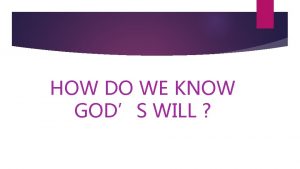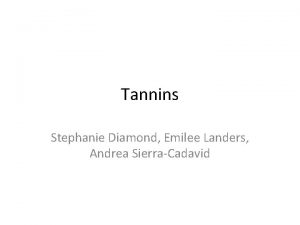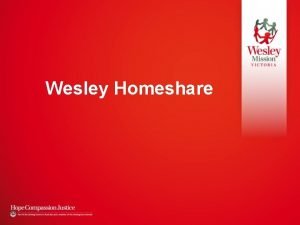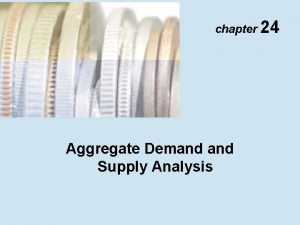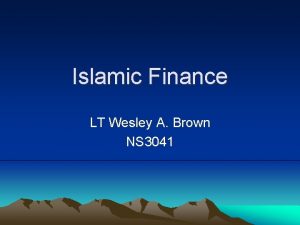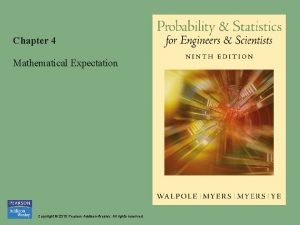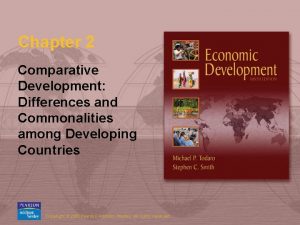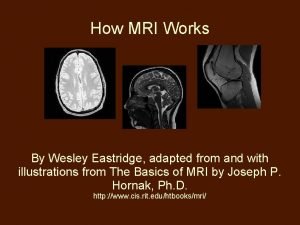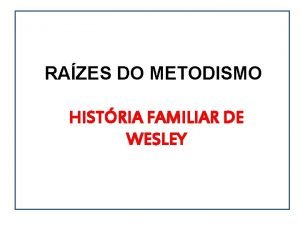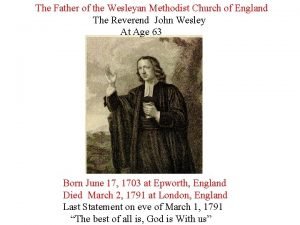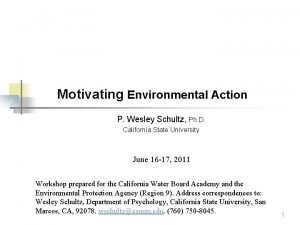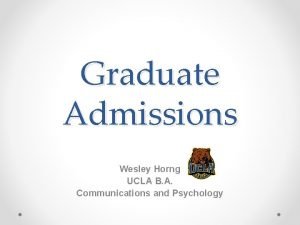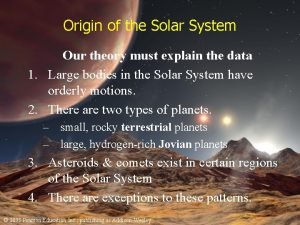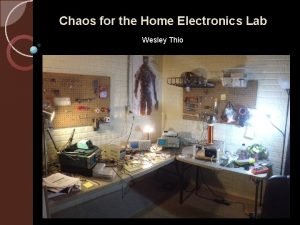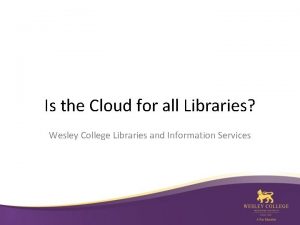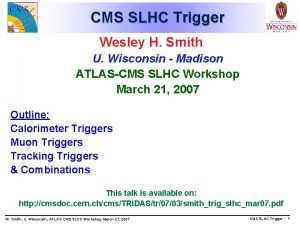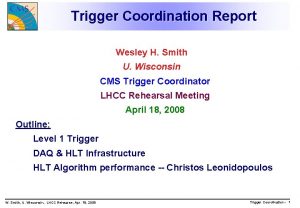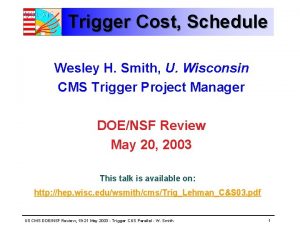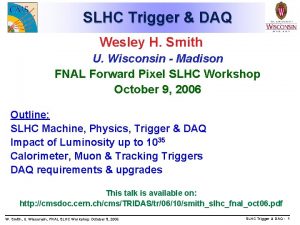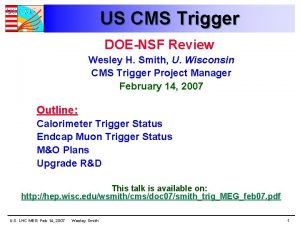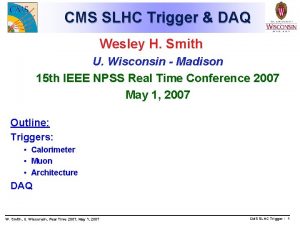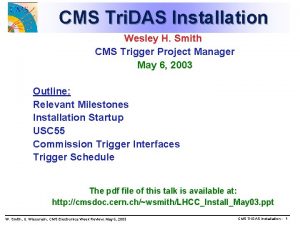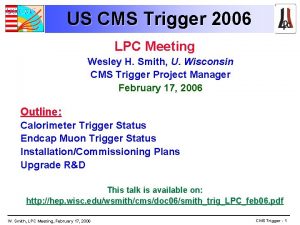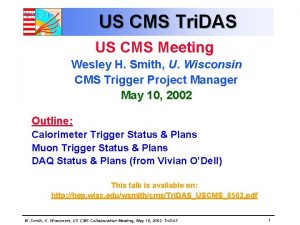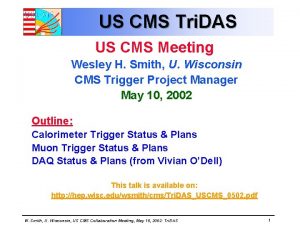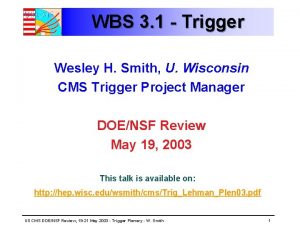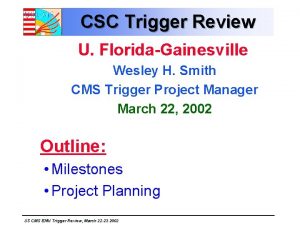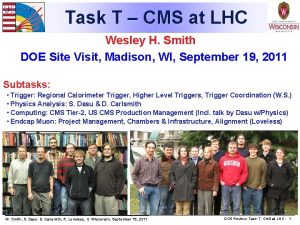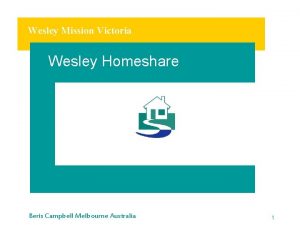Trigger Wesley H Smith U Wisconsin CMS Trigger




















- Slides: 20

Trigger Wesley H. Smith U. Wisconsin CMS Trigger Coordinator CMS Plenary Session February 25, 2008 W. Smith, U. Wisconsin, CMS Plenary, Feb. 25, 2008 Trigger - 1

HLT Online Demonstrated Capability HLT executed in validation Filter Farm • Operates as if data were provided by DAQ system • 1 rack ( 20 PC’s) of the DAQ at P 5 Online conditions • XDAQ environment, asynchronous event loop, DB conditions from local frontier squid Test Events: • 20 Million un-weighted Min. Bias events in raw data format • Skimmed on the basis of the L 1 results (menu from CMSSW 174) • ~100 k event available for feeding the HLT • 10 k events only taken as initial statistics • Each FF node can deal only with ~1 k events in replay mode Scale by performance to FF Nodes: HLT code: 43 ms/ev • Assumes 3 GHz nodes used for Filter Farm • Confirms HLT exercise result from Summer ‘ 07 • Use 100 ms/event/core in subsequent calculations for safety W. Smith, U. Wisconsin, CMS Plenary, Feb. 25, 2008 Trigger - 2

DAQ Capability 100 k. Hz EVB (readout) installed Use of EVB Farm as 25 k. Hz EVB + limited Filter Farm • With 100 ms/core (@2 GHz on EVB nodes): 14 k. Hz • Could be factor of 2 off, but present HLT measured 43 ms on 3 GHz • Operational Now • Drop to 7 k. Hz during May (recable) & August (integration of new PCs) Dedicated Nodes for Filter Farm • Purchase of 400 PCs (two quad-core @ 3 GHz) • Capacity 36 k. Hz • Operational: expect end of summer Storage: (i. e. HLT accept rate) • Expect about 0. 7 k. Hz peak, assuming 1. 5 MB evt size (1 GB/s) • Local Storage: Now: 22 TB, Mar: 50 TB, ~June: 100 TB • 100 TB = 28 hours at 1 GB/s • Link to Tier-0 (1 10 Gb/s & one spare -- needs sustained throughput) W. Smith, U. Wisconsin, CMS Plenary, Feb. 25, 2008 Trigger - 3

Summary of DAQ Capability vs. Time (tentative) Feb Mar Apr May Jun Jul Aug Sep Oct Nov Dec 50% EVB Daq Daq test - - - - 50% EVB GR GR GR ~7 ~14 - - - ~36 + GR GR HLT @EVB k. Hz HLT @FF k. Hz Cable 50% CMS GR CR B=0 T LHC beam Integr. CR B=4 T ready (+) depending whether contingency needed can add more nodes W. Smith, U. Wisconsin, CMS Plenary, Feb. 25, 2008 Trigger - 4

Trigger & DAQ Commissioning, Testing & Operating Plans Now: • Testing Storage Manager • First transfers to T 0 over CDR links (120 MB/s so far) Mar: • Technical run: EVB farm (640 PCs) in SCX configured as EVB + limited HLT & transfer to CDR T 0 link April: • Cosmic Run at B=0 • Cosmic Ray Triggers, noise rate measurements June: • Cosmic Run at B=4 T (CRAFT) • Ready for Beam if available • Full L 1 & HLT Startup menu (modulo timing change for beam) W. Smith, U. Wisconsin, CMS Plenary, Feb. 25, 2008 Trigger - 5

Startup Luminosities Approx 30 days of beam time to establish first collisions 1 to N to 43 to 156 bunches per beam Bunches 1 x 1 * 18 Ib 1010 Luminosity 1027 Pileup Low Minbias rate 55 Hz 43 x 43 18 3 x 1010 3. 8 x 1029 0. 06 20 k. Hz 43 x 43 4 3 x 1010 1. 7 x 1030 0. 28 60 k. Hz 43 x 43 2 4 x 1010 6. 1 x 1030 0. 99 200 k. Hz 156 x 156 4 4 x 1010 1. 1 x 1031 0. 50 400 k. Hz 156 x 156 4 9 x 1010 5. 6 x 1031 2. 3 2 MHz 156 x 156 2 9 x 1010 1. 1 x 1032 5. 0 4 MHz Calculation relating pileup, luminosity & bunch structure corrected (+20%) W. Smith, U. Wisconsin, CMS Plenary, Feb. 25, 2008 Trigger - 6

Trigger Algorithm Status Our highest priority is initial L 1 & HLT menus for startup • Includes emulation, DQM, performance tools, & clear strategy for validation of triggers with first data (see later slides) • We are able to do this because: Have set of L 1 & HLT algorithms & thresholds for 1032 • L 1 A = 50 k. Hz/3 = 17 k. Hz • HLT out to SM: 150 Hz of 1. 5 MB events (230 MB/s) • 230 MB/s “physics” + 100 MB/s Al/Ca = 330 MB/s = 1 GB/s/3 “safety” • Using the retuned standard L 1 trigger menu in 16 X • Provides for “ECAL coincidence” for jet triggers, etc. (remove HCAL noise trigs. ) • Candidate triggers w/adjusted prescales add ~ 10 Hz & small processing time • Will add candidate triggers to standard trigger menu in 18 x/200 • Both L 1 & HLT include prescaled “relaxed” triggers • Single detector (e. g. RPC or DT or CSC only) • Reduced conditions: no isolation, lowered thresholds • Used for efficiency & acceptance studies W. Smith, U. Wisconsin, CMS Plenary, Feb. 25, 2008 Trigger - 7

Trigger Performance Status Trigger PAG validation status (1032 menu) • • • Top efficiencies look good SUSY & Exotica: investigating changes in jet paths Higgs & Tau: Underway Jet/MET: Single jet efficiencies measured, others being done B-Jet: B-jet(s), B-HT measured, B-jet + mu next e : W, Z, High-ET OK, High-ET e HLT OK w/ecal iso. retune, H next Monitoring • • • Paths being developed for monitoring & validation Data rates, Hardware status & errors, rates of physics signal flow Separate use for online DQM, Offline DQM, L 1/HLT validation Streams for rejected events, buggy events, unbiased signal candidates Proposal: rejection path defined for each factor of 10 reduction at HLT • Properly load balanced with. 3% of each trigger devoted to rejection paths • Proposal: signal paths treated as physics triggers specified by PAG, POGs • Use tag & probe to study, also add dedicated paths for certain backgrounds W. Smith, U. Wisconsin, CMS Plenary, Feb. 25, 2008 Trigger - 8

Early Trigger Pile Up Simulation preliminary first look -- ongoing study Most extreme case: In-time PU = 5 at 1. 1 1032 (156 156) • FAMOS: overlay minbias on signal directly at generation • reading from files of minbias pre-generated events • , , e POG validation, jet reco in good agreement to ~120 Ge. V • L 1, HLT rates within stat. errors of about 20% Total L 1 rate (old menu) increase 2 (needs further checks) • Max change: L 1 HT(300), Tau(30) & MET(30), Iso EG(10) & Jet(30)… • Largest effects in low threshold 2 -object triggers • Total rate within L 1 safety margin -- will adjust L 1 to account for PU HLT rate increase of 25% • Also largest effects in low-threshold 2 -object triggers • Max change: MET&HT, 2 -e, e , e-jet, -jet… • Relaxed electron paths more affected than unrelaxed • HLT thresholds & algorithms will be adjusted when studies done As expected, source of increase is from QCD 20 -30, 30 -50 W. Smith, U. Wisconsin, CMS Plenary, Feb. 25, 2008 Trigger - 9

Trigger Strategy Phases w/Beam Phase 0: • Run complete “Phase 1” program in CCAFT • “Seamless” transition from Cosmics to Beam • Modulo adjustment for timing Phase 1: • Accept all filled crossings (zero-bias) at L 1 • Run L 1 Emulator at HLT to validate (only) L 1 HW • Send all “non-empty” events to T 0 • Use “relaxed” HLT (anything > noise) without L 1 seeds Phase 2: • • • After validation of L 1 HW bits, allow L 1 HW to reject events Start prescaling zero-bias events After validation of HLT bits, allow HLT to reject events on those bits Keep prescaled HLT rejected L 1 accept. & zero-bias prescaled In parallel, operate all triggers planned for Luminosity up to 10 32 W. Smith, U. Wisconsin, CMS Plenary, Feb. 25, 2008 Trigger - 10

Triggers with first data We will start with 3 categories of triggers: Zero-Bias • Zero-bias uses either the BPTX to detect crossings with beam and/or we program to select the collisions between known full bunches • These are prescaled. Min-Bias • Next Slides Alignment & Calibration • Much of min-bias sample used for these also • See following slides W. Smith, U. Wisconsin, CMS Plenary, Feb. 25, 2008 Trigger - 11

“Min-Bias” HF Single particle • Any fiber pair over threshold (HF sums are over 6 pairs). • Should be a good trigger for studying min-bias, but many triggers may not have tracks in the central region less useful for DPGs HF ET rings around beampipe • Potentially a good minbias trigger but integrates over noise & beam backgrounds EB/EE Tower-pair over Threshold • Gives sharp turn-on with tower energy sharing, equals electron L 1 w/o any isolation • Useful even without the APD gain change (x 4). • Should catch 33% of particle production w/ from 0 decays • Set trigger tower thresh. ~ 150 Me. V. Many events have multiple particles. • Especially useful for ECAL calibration. HB/HE Tower over Threshold • Noise is a concern. “Open Muon” • Not really “min-bias”: CSC LCT, DT Segment, RPC open road, RBC Beam Scintillator Counter Coincidence • This has a poor acceptance but adequately illuminates the tracker. W. Smith, U. Wisconsin, CMS Plenary, Feb. 25, 2008 Trigger - 12

“Min-Bias” Status HF Single particle & HF ET rings around beampipe • Code Implemented in GCT Emulator (HCAL TPG Emulator being updated) • Will be included in 2. 0. 0 and should be compatible with releases since 170 • Calculation of the 2 inner rings now in GCT Leaf Card Firmware • Path through GCT wheel & concentrator being defined. • HF single particle being prepared in GCT Firmware • Plan for availability when Jet Trigger Commissioned (end March) EB/EE & HB/HE Tower over Threshold • Can be enabled in emulator with simple configuration change • Operating in Global Runs using Electron path through GCT “Open Muon” • Emulation & FW exists, but is a matter of configuration. BSC Coincidence • Hardware ready for installation -- planned for May • HF-front-face BSCs (not the 2 x 2 small paddles on the back of HF yet) are in CMS GEANT & CMSSW up to the sim hits. • Note: BSC hits are not recorded in the readout • Exact trigger logic is under discussion W. Smith, U. Wisconsin, CMS Plenary, Feb. 25, 2008 Trigger - 13

Next Steps for “Min-Bias” Triggers Measure thresholds and the noise rates • Do this first in Global Runs, then Cosmic Run at 0 T, CRAFT Thresholds set at 5 - 7 sigma above noise. • From measured rates Test the HLT algorithms run on these samples • Start with HLT menu for 4 1029 (next slide) • Get Feedback from DPGs & PAGs W. Smith, U. Wisconsin, CMS Plenary, Feb. 25, 2008 Trigger - 14

First Look at HLT for 4 1029 Jet(MET) L 1_Single. Jet 15 L 1_Single. Jet 30 L 1_ETM 30 HLT thresh [Ge. V] 30 60 30 10 1 1 HLT Rate [Hz] 15 55 15 Electron L 1_Single. EG 5 5 1 5 Photon L 1_Single. EG 5 10 1 33 OR of All Mu. Seeds none 1 34 Trigger object Muon L 1 Seed ALL Prescale 140 Preliminary -- ongoing study W. Smith, U. Wisconsin, CMS Plenary, Feb. 25, 2008 Trigger - 15

Alignment & Calibration Triggers Calibration • phi-symmetry trigger: needed by ECAL and HCAL. • Will use min. bias & output Rec. Hits only • Requesting 1 k. Hz of min. bias and 1 k. Hz of dijets at L 1. • Single path for ECAL and HCAL • Plan is to continue testing and integrate for 2_0_0/CSA 08. • 0 ECAL trigger: • regional unpacking around L 1 EM candidates. • 1 k. Hz of 0 for 1% calibration. • Output size: 2 k. B/evt. • Plan is to continue testing & integrate for 2_0_0/CSA 08. Alignment • Cosmics for tracker/muon barrel alignment • Hope to collect 25 k muons with p > 50 Ge. V in 2 weeks (RBC trigger) • Beam Halo • BSC for tracker & CSC beam-halo for muon endcaps -- working on HLT path • "wide open" single muon for startup -- working on HLT path • single- and di-muon triggers from physics stream (express). W. Smith, U. Wisconsin, CMS Plenary, Feb. 25, 2008 Trigger - 16

Trigger Menus for CSA 08 Considering two scenarios (straw-man examples) • 2 1030 & 2 1031 • Integrated luminosity: 1 pb-1 & 10 pb-1 after 1 month of running • Assuming initial 20% duty cycle Emphasis on triggers for • Alignment and calibration • Detector/physics commissioning • Trigger monitoring and validation Differences in menus between 2 1030 & 2 1031 • Give more bandwidth to “physics” at 2 1031 W. Smith, U. Wisconsin, CMS Plenary, Feb. 25, 2008 Trigger - 17

HLT Data Model, Config DB Old data model (1_7_x and earlier): • Save all intermediate HLT byproducts for all events • Increases event size, inefficient memory usage, many small data structures • Large number of ROOT branches and "splitting” • Reduction crucial: large # of root branches streaming at T 0 very demanding. New data model (as of 1_8_x): • Save all intermediate HLT byproducts for small fraction of events • HLT commissioning phase • Save high-level trigger objects only for analyses/AOD • HLT book-keeping: saves info in same format for all HLT paths • Pack all information up in single compact efficient data structure • Reduction in # of branches (preliminary): -50% in AOD, -15% in FEVT • Reduction in event size (preliminary): -20 to 25% in AOD, -15% in FEVT Configuration Data Base • Online & offline HLT now work with Configuration Data Base • Integration with Fast. Sim soon W. Smith, U. Wisconsin, CMS Plenary, Feb. 25, 2008 Trigger - 18

Trigger Coordination Organization & LINKS POG Link Offline Link 2008 PAG Link Offline Link DPG Link Trigger DPG Physics Object Groups Offline Reco & Fwk Physics Analysis Groups W. Smith, U. Wisconsin, CMS Plenary, Feb. 25, 2008 Offline Release Planning L 1 Trigger DPG Trig. Perform. L 1 Data Monitor Algorithm perform. Online DQM Offline DQM Lorenzo Agostino L 1 Emulator Data/Emul. Comp. L 1 DQM modules Nuno Leonardo Emulator code L 1 unpack code Jim Brooke Trigger - 19

Trigger Conclusions • Well-integrated team is in place • HLT now validated under “real” operational conditions • Readout, Filter Farm, & Storage capability & evolution well matched to expected rates & event sizes • Have a set of L 1 & HLT algorithms & thresholds for 1032 • Pileup studies are producing first results • Good progress on DQM online, offline & algorithm performance • Definition of monitoring streams underway • Have a well-defined strategy for testing & implementation of physics, alignment & calibration triggers from startup luminosity on up • Zero-bias & several different min-bias triggers • Triggers being readied for testing in CR at 0 T, CSA 08, CRAFT… • Ready for beam from June onwards W. Smith, U. Wisconsin, CMS Plenary, Feb. 25, 2008 Trigger - 20
 Cms trigger system
Cms trigger system John wesley quadrilateral image
John wesley quadrilateral image Addison wesley longman
Addison wesley longman Wesley chapel high school
Wesley chapel high school Wesley mission victoria
Wesley mission victoria Wesley mission ringwood
Wesley mission ringwood Addison wesley longman
Addison wesley longman G2ctl
G2ctl Wesley homeshare
Wesley homeshare Pearson addison wesley math
Pearson addison wesley math Major characteristics of developing countries
Major characteristics of developing countries How do mris work
How do mris work Frases susana wesley
Frases susana wesley John wesley methodist
John wesley methodist Wesley homeshare
Wesley homeshare Ucla graduate school
Ucla graduate school Addison wesley
Addison wesley John wesley methodist
John wesley methodist John wesley quadrilateral image
John wesley quadrilateral image Wesley thio
Wesley thio Wesley college library
Wesley college library

